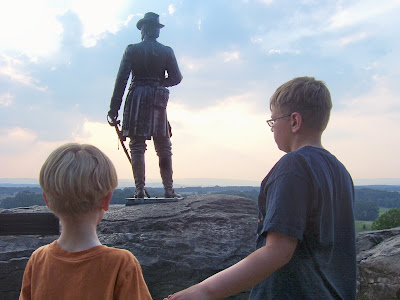Gettysburg's Little Monuments
What You Can Learn from Position Markers
Gettysburg visitors and locals are familiar with the detailed, moving monuments to all the troops that served. These monuments are often located near or at the position of a particular groups at Gettysburg. The monuments of the battlefield tell the story, often listing the number engaged, and the numbers killed, wounded, and missing. Some will also list the other battles in which a brigade or battery participated. The most detailed will include the place and date in which the soldiers were mustered in and out. You may be surprised to discover where and when the soldiers were officially no longer serving, since some of the men were mustered out far from home at the end of the Civil War. You can watch the cars drive by and slow down to read the monuments. Even the children and teens in the party are often intrigued by the emotion and art that pair with stone to create a lasting reminder for us of the sacrifices and the bravery of those who fought. This monument to the
123rd New York Infantry exemplifies that blend of emotion and art. Lit by the rays of the setting sun
Clio, the Muse of
history is writing down the record of the 123rd's service. On the monument, the star indicates that this troop belonged to the
Twelfth Corps. All the
Twelfth Corps monuments feature a star in some place. on the monument.
These monuments, often majestic and intriguing, will make people stop or slow down. However, less imposing, smaller, markers can also tell the story. Battlefield visitors walk right by these because they do not usually feature designs and often have just a few cryptic letters. To really learn about the battlefield requires a visitor to slow down -- and look down. The details of the battle story are right there in the
position markers. Position markers are full of information, once you know how to decipher the few letters inscribed on them. Many are hard to read and require you to get down next to them, but doing so will help you to really see how the troops were placed. Usually placed at the same time as the larger monuments, the position markers can tell the location of the
flanks -- or sides. These flank markers tell how far the line extended on either side. You can identify the
right flank and the
left flank by reading the monument. Thus R. F. means
right flank and L.F. means
left flank. Occasionally, the position markers will include dates. These markers were placed in most cases when veterans of the battle were still alive to describe the location, and they are so valuable because they tell us much about the soldiers. This is a position marker for the 123rd NY Infantry.
On this position marker, you can identify that they belonged to the
Twelfth Corps by the star. This marker also includes the dates July 2 & 3 1863, and stipulates that this was the
left flank. You can stand at a position marker and figure out which way the soldiers were moving, or where there attackers were located. This is a very complete marker; some are more abbreviated or harder to decipher.
This marker, also on
Culp's Hill, identifies the left flank of the
1st Maryland, of Steuart's Brigade of the CSA. Their monument is nearby this location on lower Culp's Hill.
Many markers are harder to decipher. Can you tell what the position marker on the right indicates?
This marker, also on Culp's Hill delineates the
left flank of the
29th Pennsylvania Volunteers. There is a larger monument nearby that describes the service of the 485 men who comprised the 29th.
The placement of position markers can also tell which troops fought side by side. In this picture, one sees the
right flank of the
5th Ohio Volunteer Infantry and the
left flank of the
147th Regiment Pennsylvania Volunteers. On the position marker of the Ohio men, you can also see the star of the
Twelfth Corps.
The story of the
66th Ohio Volunteer Infantry is told at the top of Culp's Hill. There you will find their monument on the east side of the hill. Close by is the position marker identifying the right flank.
The rest of the story is told several hundred yards down a steep path on the heavily forested east side of the hill. Here perched atop a boulder is the left flank monument. Finding it is well worth the walk down the steep hill because standing on the boulder and looking out toward the east, and down toward where the Confederate troops were gives you a sense of place, a sense of the wooded battlefield in which these men fought. I walked down on one of those humid 90 plus degree days of mid-July and found just walking to be difficult. The Ohio position markers, however, are not placed in the same manner as others. You can discover the arduous process of ordering and placing the monuments by reading the entries here:
http://www.gettysburgdaily.com/?p=13072
The next time you are walking through the winding roads of the battlefield, take a look down and find the position markers. Once you can decipher them, you will discover much more about the men who fought here.


















































